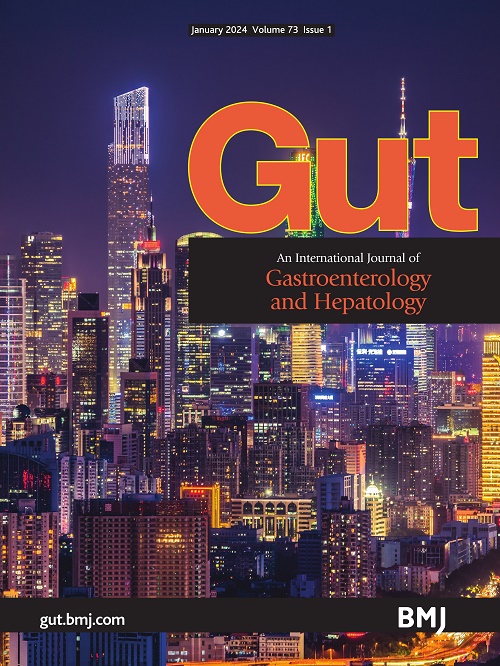HCC 免疫逃避的 Q:髓系细胞的ER应激
IF 23
1区 医学
Q1 GASTROENTEROLOGY & HEPATOLOGY
引用次数: 0
摘要
肝细胞癌(HCC)是全球癌症相关死亡的主要原因。在大多数情况下,HCC 是在已经存在肝硬化和组织重塑的紊乱肝脏微环境中发生的。肿瘤结节一旦形成,就会形成一个由肿瘤、免疫细胞、结构细胞和细胞外基质组成的复杂生态系统,并形成所谓的肿瘤微环境(TME)。3 此外,肿瘤细胞还严重依赖氨基酸谷氨酰胺(单字母代码:Q)进行核苷酸生物合成,从而实现增殖以及脂质生物合成和能量供应。另一方面,类似的代谢需求也适用于高度活跃和增殖的免疫细胞,如 T 细胞和巨噬细胞,这些细胞群的细胞功能和增殖依赖于葡萄糖和谷氨酰胺。5 因此,肿瘤组织和器官中出现了低营养供应、代谢竞争和酸性环境等恶劣条件,损害了免疫监视,从而助长了免疫逃避。在 Gut 中,Yang 等人利用小鼠模型和人体样本在临床前环境中解决了这一问题7。本文章由计算机程序翻译,如有差异,请以英文原文为准。
The Q for immune evasion in HCC: ER stress in myeloid cells
Hepatocellular carcinoma (HCC) is a leading cause of cancer-related mortality worldwide. In most cases, HCC develops in an already perturbed liver microenvironment with pre-existing liver cirrhosis and tissue remodelling. Once a tumour nodule evolves, a complex ecosystem comprising tumour, immune, structural cells and extracellular matrix develops and forms the so-called tumour microenvironment (TME).1 This TME is shaped by distinct metabolic networks particularly driven by metabolic reprogramming of tumour cells, which supports their function, as one of the hallmarks of cancer.2 For example, in many cancer types, tumour cells mostly depend on glucose consumption for their energy supply, leading to lactate production and acidic conditions in the TME even with enough oxygen (Warburg effect).3 In addition, tumour cells also heavily rely on the amino acid glutamine (single letter code: Q) for their nucleotide biosynthesis and thus proliferation as well as for lipid biosynthesis and energy supply.4 On the other hand, similar metabolic demands also apply for highly active and proliferative immune cells such as T cells and macrophages, cell populations depending on glucose and glutamine for cell function and proliferation.5 Consequently, harsh conditions with low nutrient availability, metabolic competition and an acidic milieu in the TME emerge and impair immunosurveillance thus fuelling immune evasion.6 Yet, the exact mechanisms of how metabolic reprogramming of tumour cells results in immune evasion remain only partly understood. In Gut, Yang et al addressed this question in a preclinical setting using mouse models and employing human samples.7 The study was based on the observation, that in …
求助全文
通过发布文献求助,成功后即可免费获取论文全文。
去求助
来源期刊

Gut
医学-胃肠肝病学
CiteScore
45.70
自引率
2.40%
发文量
284
审稿时长
1.5 months
期刊介绍:
Gut is a renowned international journal specializing in gastroenterology and hepatology, known for its high-quality clinical research covering the alimentary tract, liver, biliary tree, and pancreas. It offers authoritative and current coverage across all aspects of gastroenterology and hepatology, featuring articles on emerging disease mechanisms and innovative diagnostic and therapeutic approaches authored by leading experts.
As the flagship journal of BMJ's gastroenterology portfolio, Gut is accompanied by two companion journals: Frontline Gastroenterology, focusing on education and practice-oriented papers, and BMJ Open Gastroenterology for open access original research.
 求助内容:
求助内容: 应助结果提醒方式:
应助结果提醒方式:


